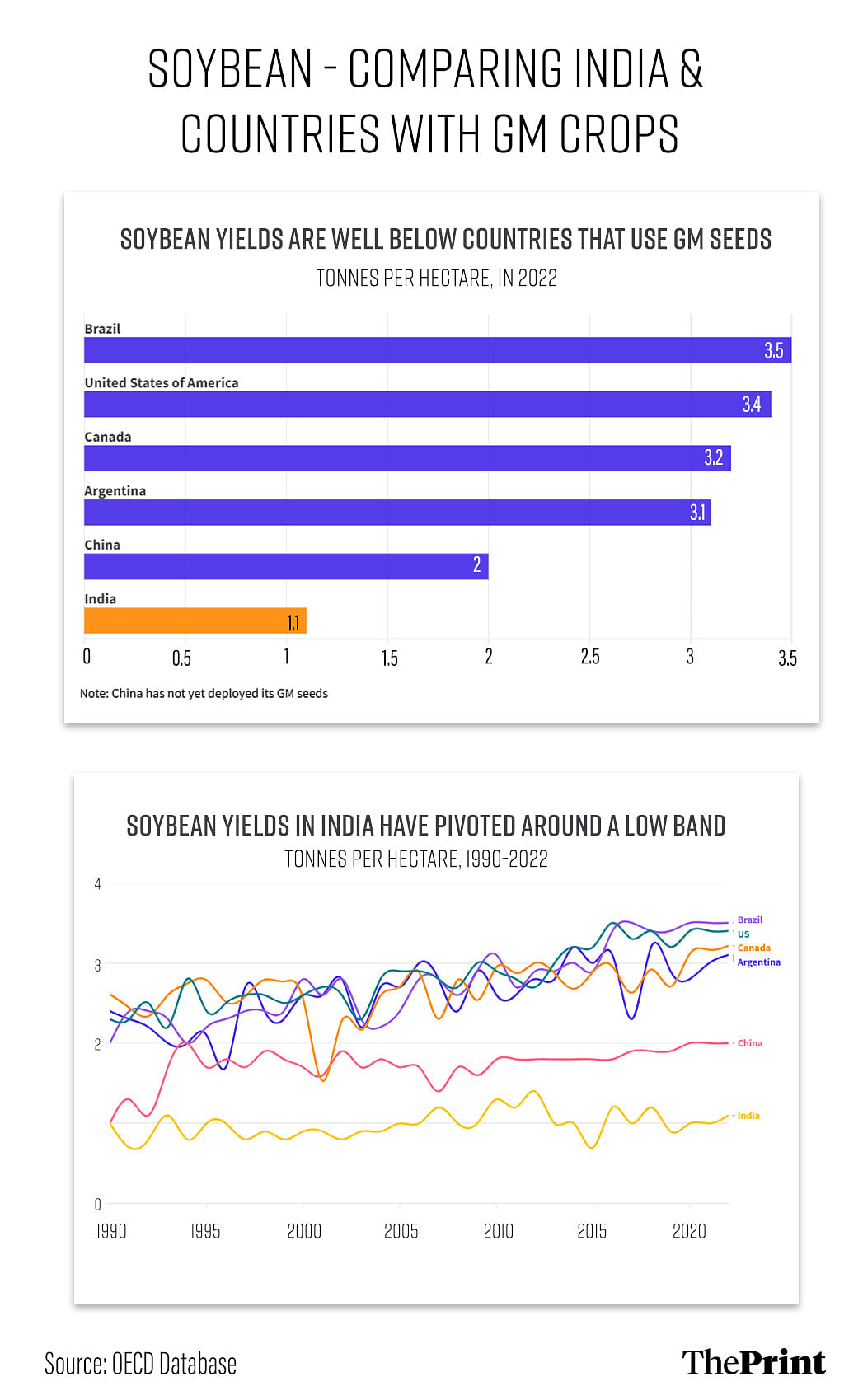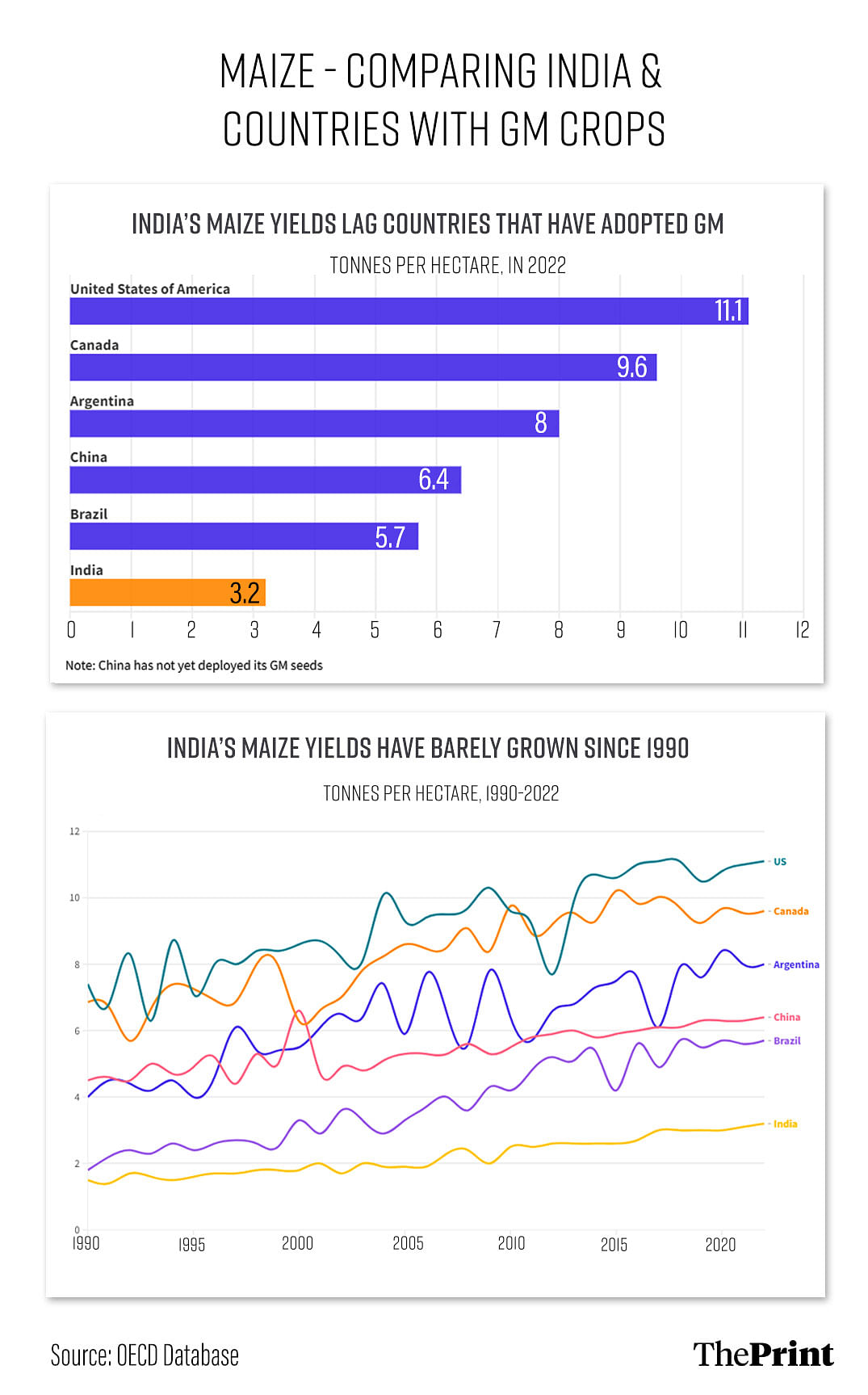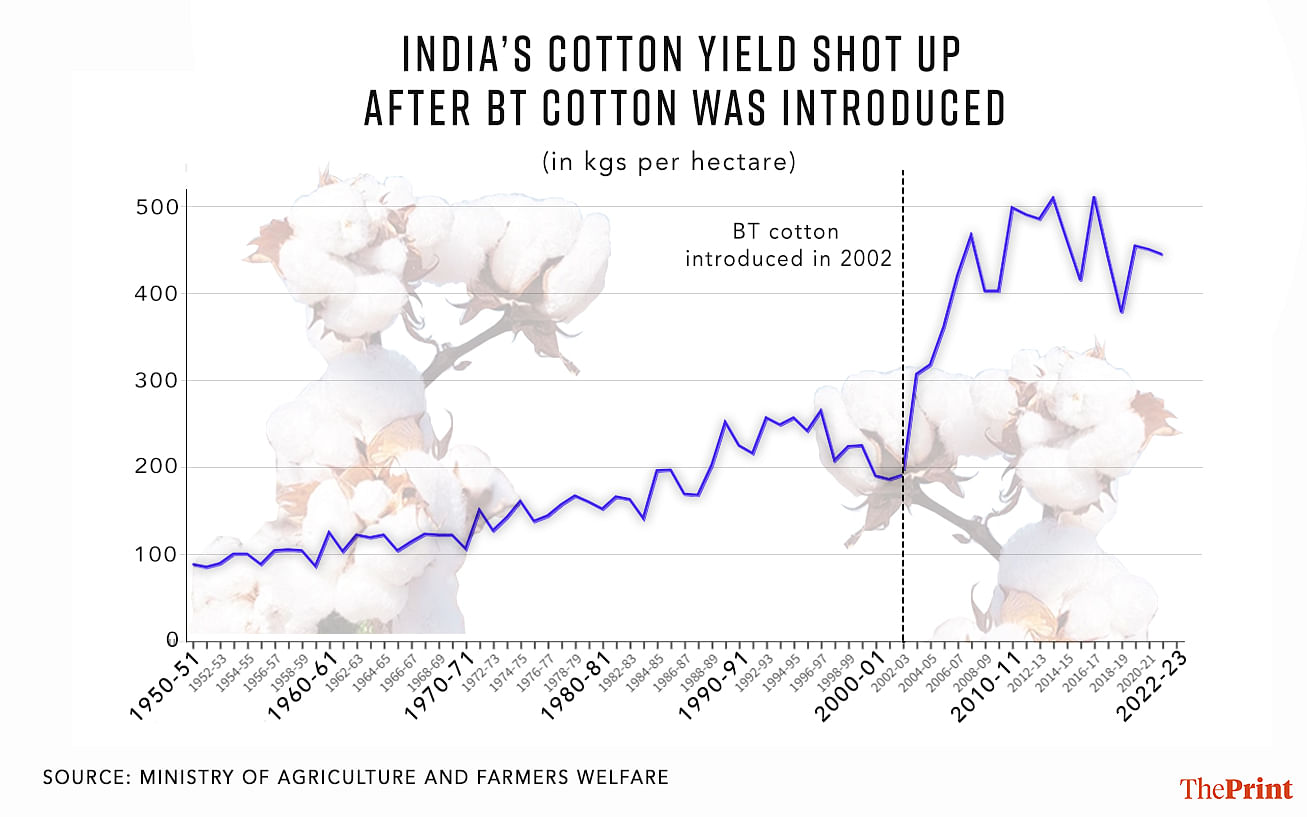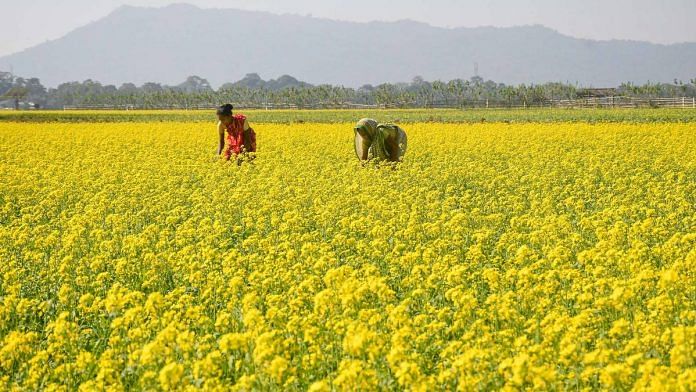New Delhi: China’s moves since October 2023 to approve several genetically modified (GM) strains of maize and soybean have shined a spotlight on India’s own GM journey and how lengthy legal tangles and government moratoriums have condemned Indian agriculture to low yields and output levels.
After decades of shared hesitation with India over GM crops, China has broken away and joined the likes of the US, Canada, and several South American and African nations in embracing GM technology to boost crop yields.
China’s break from its past hesitation has come not only in the form of extensive research and development of GM seed varieties, and a strengthening of its regulations, but also as more direct action in the form of espionage and theft from the US of its proprietary GM intellectual property.
The US Federal Bureau of Investigation (FBI) had in 2016 convicted Chinese nationals for stealing GM corn seeds in the state of Iowa. More recently, in 2020, FBI Director Christopher Wray spoke about how the FBI had caught non-state actors “working on behalf of the Chinese government, basically digging up seeds into the cover of night to steal them”.
The Chinese media has reported that its government, in October 2023, approved 37 GM maize varieties and 14 GM soybean varieties. More recently, in March 2024, it approved a second batch of 27 additional maize and three soybean varieties.
China, India on diverging GM paths
China’s moves come when India continues to ban the use of most high-yield GM varieties of crops. The only genetically modified crop India has so far allowed is Bt cotton, so named because the genetic modification allows the plant to produce a toxin, Bacillus thuringiensis, which can act as an in-built pesticide.
According to agricultural economists, India needs to urgently move forward with much of the rest of the world and develop other GM crops to improve yields and become competitive in world markets.
China’s GM journey began in 1993 and includes long years of research, development, strengthening of regulations, and now, even alleged espionage and theft.
Contrast this with India’s journey. At the moment, India’s foray into GM mustard remains mired in the Supreme Court, more than 20 years after hearings first began in the case.
Bt brinjal, another GM crop India had initially given approval to, was in 2010 placed under an indefinite moratorium pending appropriate tests being conducted. That process is still underway, while even India’s neighbour Bangladesh has adopted the use of Bt brinjal.
According to veteran agricultural economist Ashok Gulati, India should take inspiration from the success of Bt cotton, which was approved by the Vajpayee government in 2002, and has since seen a huge increase in crop yields.
According to Deepak Pental, a distinguished genetic scientist who developed India’s first variety of GM seeds in the form of Bt mustard, another way India is losing out is that the bulk of the scientific community has stopped working in the field of genetic engineering of seeds due to there not being any progress in the area for decades.
“The scientific community stands deskilled in these technologies, because if you don’t release anything and it becomes so cumbersome to get anything released, naturally scientists will avoid going into that area,” Pental told ThePrint. “And if you don’t learn an art or practise an art, you forget it.”
Also read: Disease-resistant potatoes, fortified bananas — 2 more GM crops get govt nod, trials this year
India lags behind in crop yields
According to the US National Centre for Biotechnology Information (NCBI), soybean and maize have the largest adoption of GM varieties worldwide, with GM soybean accounting for nearly half of global soybean production, and GM maize accounting for a third of global maize production.
For both these crops, not only do yields in India lag far behind those in countries that have adopted GM varieties, but Indian yields have also barely changed over the past three decades.

Data with the Organisation for Economic Co-operation and Development (OECD) shows that India’s soybean yield stood at 1.1 tonnes per hectare in 2022, around a third of yield levels in all major producers that have adopted GM varieties such as Brazil (3.5 tonnes), the US (3.4 tonnes), Canada (3.2), and Argentina (3.1 tonnes), and half of even pre-GM China (2 tonnes).
The data also shows that all the countries that adopted GM soybean have seen their yields grow rapidly over time. Contrast this with India, where yields have remained largely the same for the last 30 years — from 1 tonne per hectare in 1990 to 1.1 tonnes per hectare in 2022.
As a result of these stagnant yields, India’s soybean output has also remained stagnant for more than a decade. India produced 12.7 million tonnes of soybean in 2010, which has since grown to just 12.9 million tonnes as of 2022.

In the case of maize, for which China has introduced GM varieties over the past six months, India’s yield levels lag significantly behind the yields in countries that have moved forward on planting GM varieties. In the case of the US, for example, maize yields are 3.5 times what they are in India. Canada’s yield levels are triple those of India.
India managed to increase its maize yield levels to 3.2 tonnes per hectare in 2022 from 1.5 tonnes in 1990, but this improvement pales in comparison to the yield increases seen in countries that have adopted GM maize. For example, the US increased its yields to 11.1 tonnes per hectare in 2022 from 7.4 tonnes in 1990.
Argentina doubled its maize yields during this time, to 8.03 tonnes per hectare from 4.04 tonnes. Brazil more than tripled its yields to 5.7 tonnes from 1.8 tonnes over this period.
According to Shweta Saini, an agricultural economist and co-founder of Arcus Policy Research, India is set to face a deficit in maize, which can likely only be covered up through GM seeds.
“From a purely economic angle, if the poultry and alcohol industries — both of which use large amounts of maize — continue growing as they are, India will face a severe deficit of the crop, with simple hybridisation not being able to cover up this deficit,” Saini told ThePrint.
When it comes to food crops, the urgent need is to increase yields, Saini said, adding that this doesn’t necessarily have to be through GM varieties.
“What I can also see in food crops is that yields are not resilient to climate factors,” she said. “So, it may be GM, or it may just be climate-resistant, drought-resistant, flood-resistant, or heat-resistant varieties, but something is certainly needed. Yield is the factor agriculture needs to pivot on now.”
Also read: ‘Can’t ignore GM mustard’: Modi govt’s principal scientific advisor cites food security, imports
China’s determined advancements in GM crops
China’s moves to adopt GM varieties of crops combine long years of research, development, and testing with a more recent foray into alleged espionage and theft.
According to a 2022 research paper published by the NCBI, China’s GM development can be categorised into four phases: an exploratory phase (1993-2000), the development phase (2001-2010), a phase of improvement of regulations (2011-2020), and the current phase (2021-present), where regulations are now in place for the widespread use of GM crops in China.
During the first phase, the Chinese government in 1993 issued the first formal regulation on GM crops, to do with Bt cotton. This set the stage for the fine-tuning of regulations that would follow.
“During the development stage, the Chinese government issued a series of administrative measures, which covered almost all the fields relative to GMO safety when the basic regulatory system was established,” the paper said.
Amid controversy in China and internationally over the safety of GM crops, the paper said China used the improvement phase of 2011-2020 to “greatly improve” its GM regulations.
“From 2021, a few additional revisions have been made, and meanwhile, the new regulation on gene-edited crops was introduced with the development of biotechnology, forming a relatively complete regulation and law system for China,” the paper said. “The well-developed GMO regulations establish a firm basis for safe use of GM crops in China.”
Foray into GM espionage & theft
China’s ‘improvement’ phase of GM development also seems to coincide with arrests made by US authorities of Chinese citizens allegedly involved in espionage and theft of GM seeds developed in the US.
“We had a case, I can’t remember which state it was, not that long ago, where they caught various non-state actors working on behalf of the Chinese government, basically digging up seeds into the cover of night to steal them,” the FBI’s Wray said while speaking in the US in 2020.
“We had another one where they were caught at the airport with the seeds in their luggage to try to bring them back,” Wray added.
In 2016, a US court sentenced a Chinese national in the state of Iowa for stealing trade secrets. However, these secrets were not military blueprints, specialised software or high-tech gadgets. He was stealing seeds of maize, or corn, as it is called in the US.
“The object of Mo Hailong’s five-year conspiracy was to steal proprietary corn seeds from fields in Iowa — and across the farm belt of the Midwest — and send them to China, where Mo’s employer, a Chinese corn seed company, was based,” the FBI wrote on its website.
The FBI’s article said that authorities were first notified of Mo’s activities as far back as 2011, but took till 2016 to fully unravel the entire plot, which involved tracking five conspirators across six states.
“Our counterintelligence mission is to protect America’s vital assets,” Bill Priestap, assistant director of the FBI Counterintelligence Division, said at the time. “It just so happens that in this case, the vital assets are corn seeds, which take a tremendous amount of time and money to develop.”
Also read: How MS Swaminathan, father of India’s Green Revolution, got GM crops ‘all wrong’
What’s holding up GM crops in India?

India’s cotton yield grew to 186 kg per hectare in 2001-02 from 88 kg per hectare in 1950 — a doubling in nearly 51 years. With the implementation of Bt cotton in 2002, the cotton yield grew to 510 kgs per hectare by 2013-14 — a nearly threefold increase in 11 years. It remains at a relatively high level.
“But in India, there’s this ideological resistance to GM crops,” Gulati said. “On the other hand, cotton seeds are fed to all the milch animals, and in places like Gujarat, cottonseed oil is a household consumption item. So there’s a double face to this.”
“But if they want to continue resisting GM crops, they will have to be satisfied with low yields,” Gulati added.
Besides cotton, India has approved the release of GM varieties of brinjal and mustard. However, the environmental release of both crops has been stymied by governmental delays and legal issues, respectively, and both at the behest of environmental activists.
The Indian Council of Agricultural Research is in the process of developing GM varieties of cotton (different strains from what was approved in 2002), papaya, brinjal, banana, chickpea, pigeonpea, potato, sorghum, brassica, rice, flax, wheat and sugarcane.
In 2009, the Genetic Engineering Appraisal Committee (GEAC) — the apex body constituted by the environment and forests ministry to give approvals for the use of GM crops — approved the use of a particular strain of genetically modified brinjal, which was resistant to the brinjal shoot fly.
However, in February 2010, then environment minister Jairam Ramesh issued a moratorium on Bt brinjal use, awaiting testing that would satisfy the concerns of the “public and professionals”.
“The issue of safety tests has been raised repeatedly by critics of Bt-brinjal,” Ramesh wrote in his decision. “The kind of testing done, it is being said, is not specific or stringent enough to detect toxins. This is an important issue since brinjal is an item of almost daily consumption for most of us.”
In addition, Ramesh raised concerns about the involvement of American agrochemical company Monsanto in the production of Bt brinjal.
“Very serious fears have been raised in many quarters about the possibility of Monsanto controlling our food chain if Bt-brinjal is approved,” Ramesh wrote. “As a country, we must learn to derive the full benefit of Monsanto’s expertise and capabilities, without jeopardising national sovereignty and also develop countervailing power to it.”
As a result of his concerns, Ramesh imposed a moratorium on the release of Bt brinjal “till such time independent scientific studies establish, to the satisfaction of both the public and professionals, the safety of the product from the point of view of its long-term impact on human health and environment”.
More than 14 years later, the government and its testing agencies are still struggling to meet this stringent requirement, especially the one relating to meeting the satisfaction of the “public”.
Also read: More than 50% edible oil imported — ban on GM Mustard ‘against national interest’ Centre tells SC
GM mustard languishes in court
Back in 2004, Gene Campaign, an NGO working in the agriculture and climate resilience space, filed a writ petition before the Supreme Court seeking, among other things, a moratorium on various permissions, approvals, and trials concerning genetically engineered organisms, including plants, “till the rules are amended and a sound regulatory and monitoring system is put in place”.
This matter has been in court for the past 20 years. In January 2024, the Supreme Court reserved its judgment on the matter without providing a date for giving its judgment.
The GEAC had approved the environmental release of GM mustard on 18 October, 2022. However, the government said the environmental release of the seeds is on hold as the matter is in Supreme Court.
In a February 2023 reply to the Lok Sabha, then Union Minister of Agriculture and Farmers’ Welfare Narendra Singh Tomar said field trials were carried out for three years to assess the impact of GM mustard on human health and the environment.
“Extensive studies carried out on toxicity, allergenicity, compositional analysis, field trials, and environmental safety studies of GM mustard lines vs. their non-transgenic comparators have provided evidence that the GE mustard hybrid DMH-11 and its parental lines are safe for cultivation and for food and feed use,” he said.
This is an assessment shared by Pental, who said that the science academies of developed countries have all said this technology is no more dangerous than conventional technology.
“Whatever has been released has been found to be absolutely safe so far,” Pental said. He added that the first GM mustard variety that was made in India in 2002 had a 20-25 percent higher yield than conventional mustard seeds.
“After that, we should have made attempts to release better and better seeds. We have done technological work, but they cannot be released until their release is sustained in the court,” he added.
In December 2022, the government issued a statement on GM crops, saying that ICAR had been working on developing GM strains for 13 crops: cotton, papaya, brinjal, banana, chickpea, pigeonpea, potato, sorghum, brassica, rice, flax, wheat, and sugarcane.
Also read: Ban on GM mustard harms Indian farmers. Supreme Court must choose science over ideology




We are stuck with Bt Brinjal and Bt Mustard release while the world of science is moving ahead at a rapid pace. Our only GM crop Cotton which occupied 98% are a of total Cotton area in India, has amongst the lowest yield in the world. China produces the same amount of Cotton in 1/3rd of the area of India. The paradox is right under the nose of Indian regulatory authorities nearly 1 million ha area has illegal GM cotton.
So it’s not about the outdated GM technology and some idealists stopping it. It’s about lack of coherent policy for understanding and addressing challenges in our ossified public/private sector R&D in modern/traditional breeding, agronomy and other disciplines. Our focus on subsidies and populist policies and neglect on irrigation, rural infrastructure, soil health/organic carbon, mechanization, warehousing/logistics.
Once in a while advocacy pops up and shoots the magic bullet of GM crops quoting the same old experts. Ofcourse China and Bangladesh are moving ahead because of something else in addition to GM crop approvals.
The maize production enhancement is need of hour to sustain feed and upcoming bioethanol sector. At present single cross hybrid coverage in India is about 45% only. Thus, single cross hybrid coverage plus best weed and nutrient management would be key to achieve this target for next decade.
After fully exploitation of this potential can switch to GM Maize. In the data presented, the Maize productivity during 1992 to present is over doubled and at present stood 3.5 t/ha which is mainly happened due to expansion of hybrid coverage and adoption of good agronomic practices led enhancement in acreage expansion and overall productivity improvement.
So. GM is not only solution in maize. Our Maize production is 70% not irrigated with 80% acreage in kharif having no big GM solution as well.
Availability of GM for drought tolerance in maize is needed for India. We have good post emergence herbicide based weed management solutions at present in maize and thus HT maize has limited scope in next few decades. The insect tolerance Maize has certain scope in my opinion and can be prioritised.
Regards
Shankar Lal Jat
Senior Scientist
ICAR-Indian Institute of Maize Research Delhi Unit Pusa Campus New Delhi